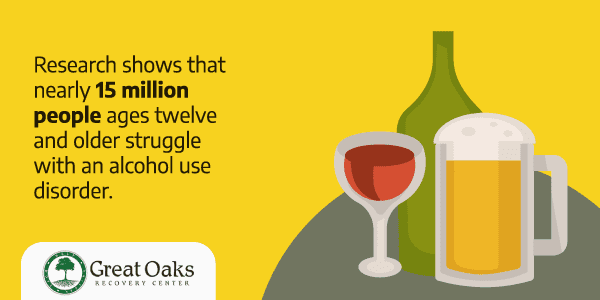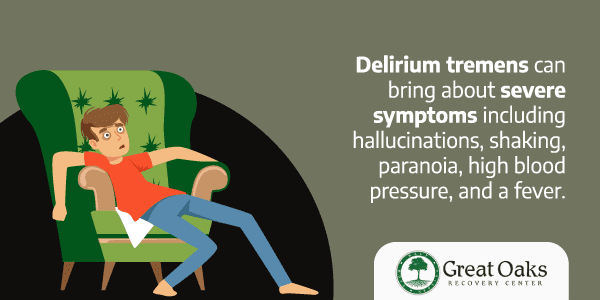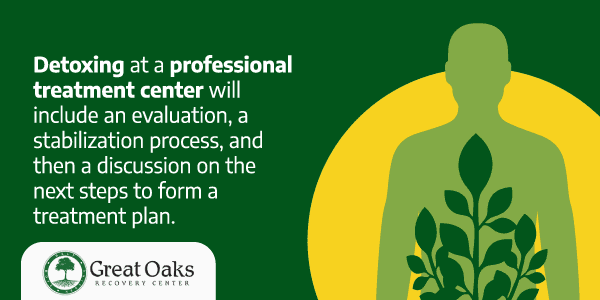What Is Drug Detoxification?
Questions About Treatment?
Our knowledgeable team is ready to discuss your situation and options. Your call is confidential with no obligation required.
What Is Detoxification?
Drug detoxification, or detox, is a term that has multiple meanings, and it is an important step in preparing an individual for addiction recovery. Detoxification can be defined as the intervention in the case of physical dependence on a drug; the process of withdrawing from a drug; and it can also refer to treatments and programs used to ease the withdrawal process. Detox also encapsulates the timeframe when an individual avoids a particular substance to rid the body of the toxins and chemicals associated with substance abuse.
Detox can happen naturally if enough time passes since an individual stopped using a drug, but a quicker and safer drug detoxification method happens when individuals detox at a medical center. When being treated at a medical center, medical professionals can prescribe certain medications and provide treatments that lessen withdrawal symptoms.
Each person’s needs vary, and the detoxification process can look different for everyone. Ultimately, drug detoxification can be beneficial in helping people with a substance abuse disorder get through the withdrawal stage, which can be the most physically and mentally difficult part of recovery.1

How Detoxification Works
Evaluation
If someone opts for a medically assisted drug detox, they will first be evaluated by clinicians who will determine which treatment is best for them. During this process, professionals will gather important information about the client, such as medical history, the substance used, the frequency of use, any mental illnesses they may have, and their physical and psychological condition.
Doctors will measure the client’s acute intoxication levels to determine withdrawal potential and use medication to assist with detox withdrawal symptoms when needed, providing therapeutic support to aid in the detoxification process. From there, a personalized treatment plan will be implemented.
Stabilization
The stabilization process involves implementing the treatments decided during the client’s evaluation. This may mean administering medications to lessen withdrawal symptoms and utilizing other therapies to ensure a safe withdrawal process. Medications commonly prescribed in detox include benzodiazepines to reduce anxiety, antidepressants to improve mood, and clonidine to help with shakiness and nausea. Doctors may also do blood tests, EKGs, and MRIs to evaluate the individual’s condition and treatment further.
Treatment Plan
Once clients are stabilized through detox, treatment centers will guide them to the next step in their recovery—their treatment plan. This varies from person to person, but it often involves longer-term interventions like rehab, psychotherapy, and support groups. While detox is an essential part of substance abuse treatment, further treatment helps sustain sobriety.
What the Drug Rehab Process is Like
Forms of Detox
The two most common forms of detoxification are cold turkey and drug tapering. Some people believe quitting a substance cold turkey is the best way to stay off a substance, but that is a myth. The ability to quit cold turkey mainly depends on the length of addiction and the severity of withdrawal symptoms. Note that quitting cold turkey can be very dangerous, leading to severe withdrawal symptoms and other complications.
Medical drug detox centers, on the other hand, generally utilize a gradual, tapering method. For example, with heroin and alcohol addictions, doctors will taper an individual off those substances and give prescription medications that act like heroin or alcohol in the body, allowing for an easier withdrawal. Then the client will gradually be tapered off the “replacement” substances—a process that can take a few weeks to a few months.
Some people may attempt to detox at home. However, an a-home detox offers none of the medical and therapeutic support that medical detox has. As a result, managing withdrawal may be more difficult without medication to minimize symptoms, and relapse may be more common without therapeutic and medical support. It is both more comfortable and more effective to detox at a professional recovery center such as Great Oaks.


Detoxification Diets
Proper nutrition can help the body heal from the damage caused by a substance use disorder. Nutrients supply the body with energy and can help speed recovery, which is why many medical detox centers offer nutritious food and diet plans for individuals to implement during and after treatment.
Addiction can affect eating habits, causing some people to gain weight and others to lose weight. Some may neglect to eat a healthy diet while facing addiction, resulting in nutritional deficiencies and even malnourishment. Eating fruits, vegetables, and minimizing processed foods can be a good way to accelerate the detoxification process. Drinking water is the most important thing to do because, without adequate hydration, the body will not be able to heal itself as efficiently.
Benefits of Certain Diets
People with an alcohol use disorder can face serious negative health consequences. Here are some dietary guidelines and food choices that can be beneficial for individuals in substance use disorder recovery:
- Hydration: Staying hydrated is essential for overall health and can help with detoxification. Aim to drink plenty of water throughout the day.
- Balanced Meals: Focus on balanced meals that include a variety of nutrients, including carbohydrates, proteins, and healthy fats. This can help stabilize blood sugar levels and provide sustained energy.
- Fruits and Vegetables: Incorporate a wide range of colorful fruits and vegetables, which are rich in vitamins, minerals, and antioxidants. These foods can support immune function and promote healing.
- Whole Grains: Choose whole grains like brown rice, quinoa, whole wheat bread, and oats. These grains provide fiber and nutrients, helping to regulate digestion and maintain stable energy levels.
- Lean Proteins: Include lean protein sources such as poultry, fish, beans, lentils, tofu, and nuts. Protein is important for tissue repair and can help maintain muscle mass.
- Healthy Fats: Consume sources of healthy fats like avocados, nuts, seeds, olive oil, and fatty fish (e.g., salmon, mackerel). These fats support brain health and can help reduce inflammation.
- Omega-3 Fatty Acids: Incorporate omega-3 fatty acids, found in fatty fish, flaxseeds, chia seeds, and walnuts. Omega-3s have been shown to support brain health and may help alleviate mood disturbances.
- Vitamin-Rich Foods: Foods rich in B vitamins (e.g., whole grains, leafy greens, eggs), vitamin C (e.g., citrus fruits, bell peppers), and vitamin D (e.g., fortified dairy or plant-based alternatives, sunlight) can contribute to overall well-being.
- Probiotic Foods: Consider including probiotic-rich foods like yogurt, kefir, sauerkraut, and kimchi to support gut health, which can impact mood and digestion.
- Avoid Sugar and Processed Foods: Limit or avoid sugary foods and highly processed items, as they can lead to energy crashes and may negatively impact mood.
- Mindful Eating: Practice mindful eating, paying attention to hunger and fullness cues. This can help foster a healthier relationship with food and prevent overeating.
- Regular Meals: Aim to eat regular meals and snacks throughout the day to maintain stable energy levels and prevent extreme hunger.
- Limit Caffeine and Stimulants: While some caffeine intake is acceptable, excessive caffeine and stimulant use can disrupt sleep and contribute to anxiety.
Combining a healthy diet with therapy, counseling, support groups, and other forms of treatment can contribute to a successful and sustainable recovery from substance use disorder.
How Long Does Detoxification Take?
There is no exact timeframe for drug detoxification. It varies from person to person and substance to substance, but there are some general guidelines that indicate how long a substance stays in a person’s system and how long they will experience the signs and symptoms of drug detoxification.
It’s important to note that detox is only the first step in the recovery process. While detox addresses the physical dependence on a substance, it does not address the underlying psychological and behavioral aspects of addiction. To achieve lasting recovery, individuals should transition from detox to comprehensive addiction treatment, which may include therapy, counseling, support groups, and other forms of behavioral intervention.
How Long Does Drug Withdrawal Last and What Helps?
Alcohol
Alcohol withdrawals begin about a day after the last drink, and alcohol detox symptoms tend to be the worst around the three-day mark. Heavy drinkers may experience more severe and long-lasting symptoms. Within a week, most people start to feel healthier and more energized.
Opioids
Opiate and opioid (codeine, fentanyl, heroin, hydrocodone) withdrawal and detoxification can take longer. Symptoms can appear within a day of abstinence or take more than a week to appear. Depending on how much and how long the substance was in the body, withdrawal symptoms can persist for up to two weeks.
Stimulants
Stimulants (cocaine, amphetamines) may be quicker to detox. These substances tend to enter and leave the bloodstream quickly, and cravings for the drug will taper off within a week or so of detoxification.
Prescription Drugs
Prescription drug detoxification (Valium, Xanax) symptoms begin within a day of abstinence and can last up to a week. By the two-week mark, the most severe symptoms and cravings tend to have tapered off.
Varying Factors
Ultimately, an individual’s detoxification timeline and recovery can only be predicted to an extent. Factors that can influence the length and severity of the detox process include:
- Genetic makeup
- Overall health and mental wellbeing
- The timeframe of substance abuse
- The method of drug use
- The amount of substance per dose
- Comorbidity
While the immediate detoxification side effects end within a short time, psychological symptoms and cravings can last much longer. Thus, ongoing therapy and support are helpful for most people in recovery.

Detoxification Side Effects and Dangers
Detoxification side effects vary depending on the substance used, but fatigue, nausea, and mood changes are common side effects experienced during medical detoxification.
Individuals who detox at home, also known as self-detox or quitting a substance without medical supervision, can pose significant risks and potential dangers. Detoxification from certain substances can lead to severe withdrawal symptoms and medical complications, which may require professional medical intervention. Attempting to detox at home without proper medical oversight can be life-threatening and is generally not recommended.
Individuals who detox at home are at a greater risk for overdose because, if they relapse, they may take a dose too high for their system to handle, as tolerance can change quickly during the detox process.
Alcohol, opioid, marijuana, and stimulant detox information and symptoms are outlined below.
Example of the Withdrawal Process During a Nicotine Addiction
Alcohol Withdrawal Symptoms
Alcohol is one of the most used substances in the United States—according to the 2019 National Survey on Drug Use and Health (NSDUH), 85.6% of people eighteen and older reported that they drank alcohol at some point in their lifetime. Nearly 26 % of people eighteen and older reported binge drinking in the previous month, and nearly 15 million people aged twelve and older have alcohol use disorder.2
According to the U.S. National Library of Medicine, alcohol withdrawal symptoms may include:
- Anxiety and nervousness
- Depression
- Fatigue
- Sweating
- Shaking and tremors
- Mood swings
- Nausea and vomiting
- Rapid heart rate
- Dilated pupils
- Confusion
- Seizures
Doctors sometimes prescribe medications like naltrexone, acamprosate, and disulfiram to mitigate nausea and other physical and emotional withdrawal side effects.
Opioid Withdrawal Symptoms
Opioids include prescription medications like oxycodone (OxyContin, Percocet), morphine, and codeine, as well as fentanyl and tramadol, which are synthetic opioid pain relievers. In 2019, it was estimated that 10.1 million people aged twelve or older misused opioids in the United States.3
Opioid withdrawal symptoms can include:
- Joint pain
- Anxiety
- Chills
- Hot flashes
- Nausea and vomiting
- Weakness
- Irritability or agitation
- Insomnia
- Sweating
- Tremors
- Increased heart rate
- Increased blood pressure
Cocaine Withdrawal Symptoms
Known as a “party drug,” cocaine has the potential to cause serious withdrawal symptoms just like other substances if someone becomes dependent on it. Additionally, cocaine overdoses are on the rise in the United States, demonstrating how dangerous using the drug can be.4
Cocaine withdrawal symptoms include:
- Fatigue
- Flat affect
- Cravings
- Mood swings
- Depression
- Agitation
- Restlessness
- Vivid dreams or nightmares
- Body aches
- Increased appetite
- Headaches
- Paranoia
- Slowed heart rate
Marijuana Withdrawal Symptoms
Due to the recent legalization of marijuana use, people may not think that it’s possible to have withdrawal symptoms, but this is a misconception. While using the drug a handful of times will not result in withdrawal upon stopping use, someone who uses marijuana daily or nearly daily for a long time will likely experience withdrawal. According to the Centers for Disease Control and Prevention (CDC), one in ten Americans who use marijuana will become addicted. That number moves up to one in six if an individual begins using cannabis before the age of eighteen.5
Symptoms of marijuana withdrawal include:
- Loss of appetite
- Sleep problems
- Mood changes
- Headaches
- Cravings
- Loss of focus
- Sweating
- Chills and cold sweats
- Depression
- Stomach problems
Light marijuana users may not experience withdrawal symptoms when quitting marijuana, but long-time users are likely to deal with withdrawal symptoms.

Drug Detoxification During Pregnancy
Drinking alcohol and using drugs while pregnant can seriously harm the mother and the unborn child. The risk for stillbirth doubles (and even triples, depending on the substance) when a mother uses substances throughout her pregnancy.6 Additionally, the unborn child is at risk for fetal alcohol syndrome, birth defects, low birth weight, premature birth, and neurological effects.
For this reason, it’s crucial for pregnant women to seek help in the form of medical detoxification. Pregnant women should not detox at home; medical supervision is crucial in protecting the health of the mother and child. If the mother is dependent on a substance, withdrawal symptoms can be particularly hard on the fetus, meaning medical oversight is necessary. Pregnant women can still take some prescribed medications to alleviate detoxification symptoms, but doctors carefully monitor dosage and side effects.
The comprehensive, twenty-four-hour support offered by medical detox assures the best outcome and treatment for pregnant women with substance use disorder.

Severe Drug Withdrawal Side Effects
For some, withdrawal can be an unpleasant but relatively smooth process—for others, it carries serious risks. Withdrawal from drugs often causes depression, which always comes with the risk of suicidal ideation. Long-term substance use or the use of a substance in large quantities poses a higher risk for severe withdrawal symptoms; additionally, quitting a substance cold turkey raises the risk for severe symptoms.
For people experiencing severe alcohol withdrawal, whether at home or at a drug detox center, there is the risk for a serious condition called delirium tremens. Delirium tremens is a severe form of alcohol withdrawal that causes hallucinations, shaking, paranoia, high blood pressure, and fever. It’s a critical condition, but it can be resolved in a few days when treated by a medical professional. The condition affects only about five percent of people experiencing alcohol withdrawal, and its effects tend to appear a few days after an individual’s last drink.7
Addiction Treatment Options
The treatment following medical detox is just as important as the detox itself. There are many successful treatment options for addiction, including inpatient care, outpatient care, therapy, and support groups.
Inpatient Care
Inpatient care offers a structured and safe environment for people to recover for the length of time that is suited to their needs. Inpatient facilities not only provide 24/7 medical and therapeutic treatment, but many facilities also have green space, art and music therapy, nutritional and spiritual advice, and more. People who have relapsed in the past may find inpatient more helpful in sustaining recovery as it is more intensive in nature.
Outpatient Care
Outpatient treatment is like inpatient, except the clients can live at home. Clients receive one-on-one medical and therapeutic care, with access to support groups and 12-Step programs. It is a more cost-effective option as the individual only pays for physician fees, testing, and treatment.
Therapies
Therapy, whether one-on-one or group therapy, is a crucial part of recovery for many people. Talking through challenges and triggers around addiction and learning to manage the stress of staying sober is important for sustained recovery. Family therapy can also help offer a safe space to rebuild trust and improve communication between the affected individual and their loved ones.
Great Oaks Detoxification Programs
At Great Oaks Recovery Center, residents detox in a safe, compassionate, and supportive environment. To ease the transition from chemical dependence, the Great Oaks team evaluates a person’s whole health profile, types of substances used, the severity of usage, and other stability factors. The detoxification process is managed by Great Oaks’ highly qualified onsite medical team, which includes licensed nurses and specifically trained professionals available twenty-four hours a day.
Drug detoxification at Great Oaks isn’t just about tests and medications—it’s about treating a person in a holistic way by getting to know their values and beliefs to provide the best care possible, tailored to each unique individual.
Great Oaks assigns an individual therapist to each person, offering support from the very beginning of the detox process. With dedicated guidance, acknowledgment of root causes, and progressive methods for behavioral management, Great Oaks helps develop a deep understanding of oneself and the substance use disorder, paving the way for a happy and healthy future.
Don’t wait to get help. Visit greatoaksrecovery.com or call (877) 278-7086 to begin the path to recovery.
Resources
- https://medlineplus.gov/dualdiagnosis.html
- https://www.webmd.com/mental-health/addiction/alcohol-detox-programs#1
- https://www.ncbi.nlm.nih.gov/books/NBK526012/
- https://www.webmd.com/mental-health/addiction/addiction-detox-what-to-know
- https://www.webmd.com/a-to-z-guides/dehydration-adults
- https://www.drugabuse.gov/publications/research-reports/substance-use-in-women/substance-use-while-pregnant-breastfeeding\
- https://www.webmd.com/mental-health/addiction/delirium-tremens
Questions About Treatment?
Our knowledgeable team is ready to discuss your situation and options. Your call is confidential with no obligation required.

